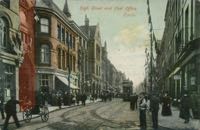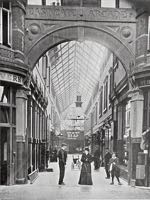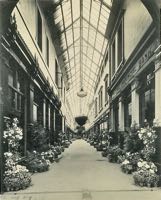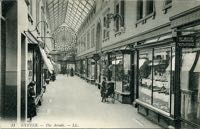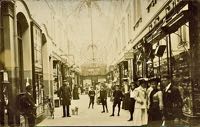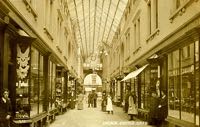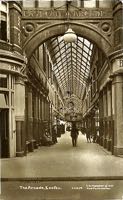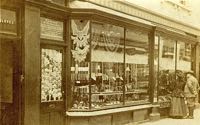
The Eastgate Arcade
Page updated 19th September 2016
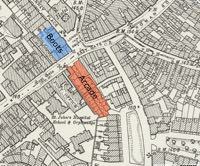 This arcade was an almost forgotten Victorian palace of shopping, of
which the Harlequins Centre is a pale imitation. Similar to the
wonderful arcades that can be found in some large northern cities, such
as the Cross and Thornton's Arcades, Leeds, the Eastgate Arcade was
built by a private, limited liability company in 1880/81. The arcade in
the High Street, was entered from the right of Eastgate House and
stretched as far as Southernhay, and was lined with a dozen shops on
each side and surmounted by a circular glass roof.
If it still existed, it would be directly opposite Boots, in the High Street.
This arcade was an almost forgotten Victorian palace of shopping, of
which the Harlequins Centre is a pale imitation. Similar to the
wonderful arcades that can be found in some large northern cities, such
as the Cross and Thornton's Arcades, Leeds, the Eastgate Arcade was
built by a private, limited liability company in 1880/81. The arcade in
the High Street, was entered from the right of Eastgate House and
stretched as far as Southernhay, and was lined with a dozen shops on
each side and surmounted by a circular glass roof.
If it still existed, it would be directly opposite Boots, in the High Street.
The Arcade was designed by James Crocker FRIBA, and was built by Messrs. Stephens & Son at a cost of £18,500. Work commenced, on Monday 12 April 1880, with the demolition of the old Master's House of the Grammar School, part of St John's Hospital School. At the same time, the new Post Office for the city was to be constructed on a site next to the new Arcade. The two foundation stones was laid on 2 August 1880, one by the Mayor and one by the Bishop.
It was ready for occupation in June 1881, when several notices were published requesting applications to rent the remaining shops. The rents were described as moderate, while they would return to the shareholders a dividend of 7½% in the first year.
The Eastgate Coffee house, to the left of the entrance, was built at a cost of £2,000 by a separate company, at the same time, and became an important meeting place in the city. On the first floor of the Coffee House was constructed a public lecture hall.
The Arcade was built in a Classic style, with a glass covered roof forming an interior street of 24 shops. Stretching to 250 ft long, 15 ft wide and 36 ft high, the floor was laid with asphalt. The High Street entrance had an illuminated clock that would shine like a beacon on a gloomy day. Beneath were a large pair of wrought-iron gates which were closed at the end of the day. At the far end, there was an exit to the top of Southernhay.
From the start, regular Promenade Concerts from the 4th Battalion Devonshire Regiment were put on to attract custom to the Arcade from soon after it opened. Protected from the elements, people could wander, and window shop. A letter to the Western Times suggested that seats should be placed centrally in the Arcade to attract shoppers from the High Street. Edwardian nannies would parade their perambulators past the Honiton lace shop, the photographers studio and jewellers to allow their sailor suited charges to stair longingly at the china dolls and clockwork Dreadnaughts displayed in the window of Noah's Ark. All this, just yards from where Perkin Warbeck had been repelled at the Eastgate, and William the Conqueror had pledged his oath to the people of Exeter. At the opposite end of the Arcade from the High Street, was a large, circular, stained glass window, where, just to the side, countless schoolboys would scamper through the wooden gates into the yard of St John's Hospital School, clutching their books and sandwiches, hoping to avoid a reprimand for their lateness. And a little later in the day, there would appear individuals in Sunday best, nervously looking for employment in service through the registry office for servants run by Miss Ellen Knowles.
Destruction in the fire storm
It was inevitable that the bombing of May 1942 would damage the Arcade. All around incendiaries were dropping, some in the road to fizz out harmlessly, but many fell on the flammable rooftops of the ancient buildings. Ironically, the Cooperative building next door, built in the 1930's of concrete and glass survived–the only structure in that part of Exeter to come through the conflagration. The fire watchers on the roof, saved the Coop by tossing the incendiaries onto the glass roof of the Arcade. They then fell through and set fire to the shops.
One report at the time said: "The fire watchers at the Arcade had great difficulty getting on to the roof and dealing with the very large number of bombs which fell there. The result was that the job was beyond them and the Arcade was destroyed."
In May 1947, the bombed site was used for a row of temporary shops.
This is a list of the shops that were in the Arcade in 1897.
Arcade, Eastgate to West Southernhay.
1 Phillips Francis, china dlr
2 Towill Frdk.Geo.watch ma
3 & 4 Mapledoram Mrs. Mary Ann, ladies' outfitter
5 Moxey & Co. jewellers
6 Arcade Photographic
6A,Caseley Hy. Arthur, hatter
7 Knowles Miss Ellen, registry office for servants
7 Dixon Mrs. Jane, lace manfr
9 Pretty Chas. Becket, hair dresser
11, 12 & 13 Coles & Willats, tailors
Entrance to WestSouthernhay*
14 Brooking & Co. electrical engineers
16 Winser Alfred Edwd. dyer
17 Hallett Miss Lucy, refreshment rooms
18 & 19 Pearce Edwin Thomas, fancy repository
20 & 20A, Barns & Van Houten, milliners
21 Norcombe Mrs. Tom, millnr
22 Cummings Richard H. umbrella manufacturer
23 Roberts Mrs. A. fancy drpr
Eastgate Coffee tavern, J Knill, sec. & manager
Arcade Lecture Hall, J, Knill, sec. & manager
First Exeter Richmond Building Society,
H. C. Mildon, sec Hocking Thomas, caretaker
Source: Newspaper articles from the British Newspaper Archive and Kelly's Directory
│ Top of Page │
